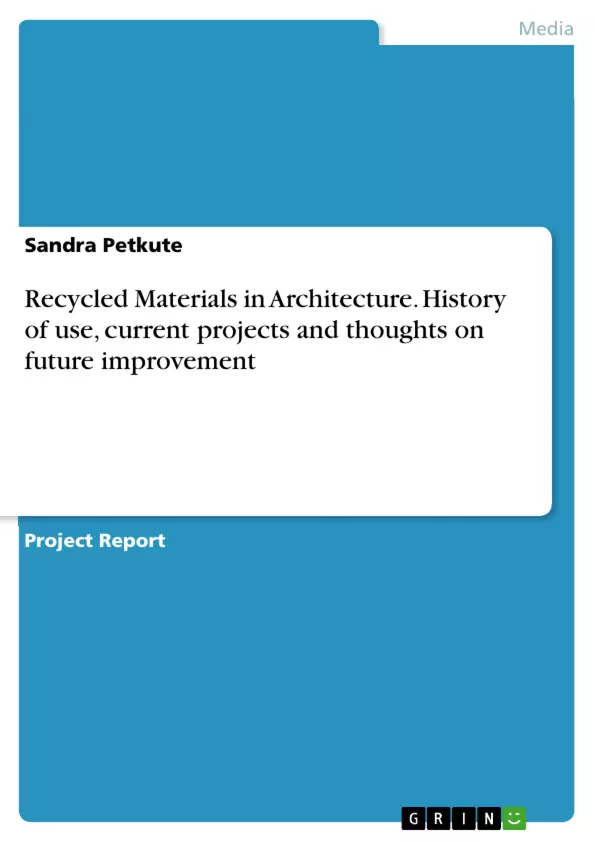This research project is concerned with the question what influence and possibilities recycled materials have in building construction and architectural appearance.
Material in this case by definition is substance that things are made of. Recycled materials automatically is represented as substances of things that are re-used for other or new purposes. The whole world is compiled out of billions of different materials, some of them are considered to be renewable and some of them unfortunately are unendurable, which leads to the coherent idea that sooner or later the Earth will lose the natural capability to meet human-society needs in terms of amount of existing materials.
Most of materials used in building industry are either organic or human-made goods, which for the records, the majority of time are made out at least partly out of organic natural substances, for instance concrete, brick, glass. It has already been about 8 thousands years, how people are building houses which requires a certain amount of materials. With an increasing number of population, the quantity of building supplies gradually raises, which leads to the concern of dwindling natural sources. For that reason, increasing information amount is becoming essential, explaining the possible ways of saving the sources as well as why is it important, what outcomes may or may not possible come if we do or do not take certain actions.
Since building industry is one of the dominating existing industries, it undoubtedly pursue to the idea that recycled materials usage into building industry for both construction and design might be one of the key actions to be taken in order to achieve sufficient results within the time and to aim more sustainable self-conscious society.
Inhaltsverzeichnis (Table of Contents)
- Preface
- Acknowledgement
- 1. Introduction
- 2. Problem formulation
- 3. Methodology
- 4. Recycled elements
- 4.1. History
- 4.2. Purpose of Recycling
- 4.3. Materials & Properties
- 4.3.1. Qualification of Materials
- 4.3.2. Properties of Materials
- 4.4. Constructional & Architectural Design Opportunities of Materials
- 4.5. Common problems
- 4.6. Existing project examples
- 4.6.1. Big Dig House
- 4.6.2. Upcycle House
- 4.7. Building Regulations
- 4.8. Introduction to the Bachelor project
- 4.9. Analysis of Bachelor project
- 4.9.1. Risk areas
- 4.9.2. Technical & Design Solutions
- 4.9.3. Sub-conclusion
- 5. Thoughts on future improvement
- 6. Conclusion
- 7. Vocabulary
- 8. Bibliography
Zielsetzung und Themenschwerpunkte (Objectives and Key Themes)
This research paper explores the use of recycled materials in architecture, analyzing its benefits, challenges, and applications. The paper aims to contribute to a more sustainable approach to building by highlighting the potential of reusing materials from existing structures and objects.
- The increasing demand for resources in the building industry due to population growth and rising living standards.
- The environmental impact of material extraction and production, and the need for resource conservation.
- The benefits and challenges of incorporating recycled materials in architectural design and construction.
- The exploration of existing projects and case studies demonstrating successful applications of recycled materials.
- The analysis of the potential and limitations of recycled materials in a specific bachelor project.
Zusammenfassung der Kapitel (Chapter Summaries)
- Introduction: This chapter establishes the context for the research by defining recycled materials and outlining the growing concern of depleting natural resources within the building industry.
- Problem formulation: This chapter presents the problem of resource depletion and the potential of recycled materials to address it. It highlights the increasing demand for building materials and the importance of sustainable practices.
- Recycled elements: This chapter delves deeper into the topic of recycled materials, covering their history, purpose, properties, and design opportunities. It also explores common problems and existing project examples.
- Analysis of Bachelor project: This chapter focuses on the specific Bachelor project, analyzing its risk areas, technical and design solutions, and potential for implementing recycled materials.
Schlüsselwörter (Keywords)
This research paper focuses on the key topics of recycled materials, sustainable architecture, building industry, resource depletion, environmental impact, design opportunities, project analysis, and bachelor project.
- Citation du texte
- Sandra Petkute (Auteur), 2015, Recycled Materials in Architecture. History of use, current projects and thoughts on future improvement, Munich, GRIN Verlag, https://www.grin.com/document/317427



